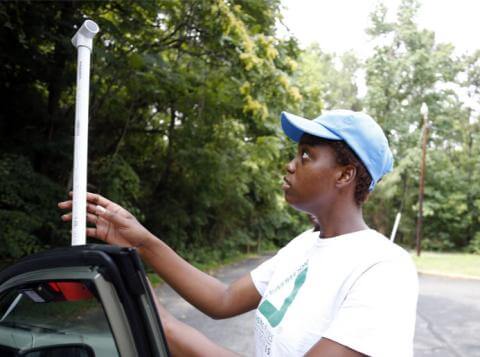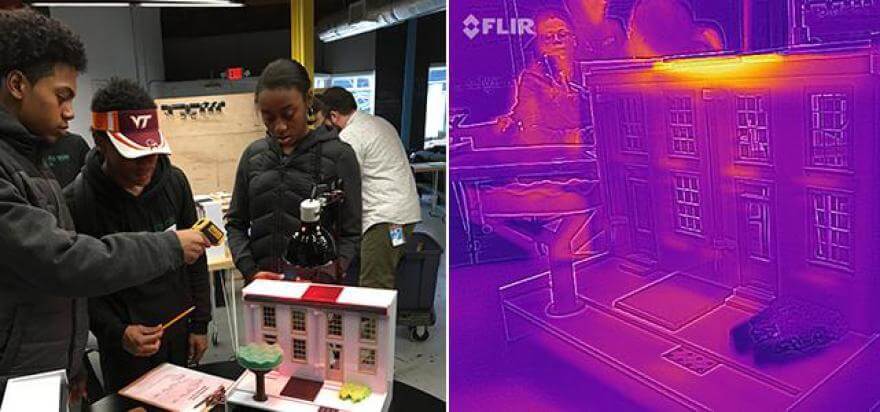Mapping Heat, Building Community
This piece was written by Abbie Dusseldorp, Groundwork USA (a Forest Service Urban and Community Forestry Program grants national pass-through partner, as is River Network) and originally appeared on the Forest Service website. Groundwork USA received Inflation Reduction Act funding. Groundwork USA and their equity-centered partner network will develop, pilot, and implement urban forestry strategies that build the capacity of disadvantaged communities to sustain and steward their urban tree canopy. Crossposted with permission.
While all trees add beauty to urban neighborhoods, their real superpower is in the invisible climate, health and economic benefits they provide—improving air quality, reducing flooding and cooling neighborhoods. Think back to your last stroll on a scorching summer day. That refreshing relief you get under the shade of a tree is not wishful thinking– average temperatures under a mature shade tree can be over 10°F cooler than direct sunlight. This difference isn’t just a nice-to-have; it’s essential. Expanding the tree canopy means more outdoor activity, safer commutes, better working conditions, lower cooling costs and so much more.

Cyclist on the Richmond Wellness Trail in California. (Photo courtesy of the Trust for Public Land)
Illuminating the benefits of trees through stories and data is key to ensuring they are planted, maintained and stewarded into the future. Community science is a powerful way to involve residents in this mission. Like citizen science, community science provides residents with the tools to collect hyper-local impact data, such as using forward looking infrared (FLIR) cameras to detect heat patterns and capture cooling benefits. Community science goes further by having residents identify the questions they wish to explore and interpret the data themselves, fostering a deeper understanding of the benefits of green infrastructure.

A Green Teamer at Groundwork RVA attaches a sensor unit to a car to collect heat data. (Photo courtesy of Groundwork RVA)
Having led community science efforts for nearly a decade, we’ve seen the power of these programs. In 2018, the “Throwing Shade in RVA” project created an opportunity for Groundwork RVA’s Green Team to map temperature variations across Richmond, Virginia. Using handmade devices, they discovered temperature differences of up to 16°F on the same day along popular transit routes. Their findings, also using FLIR cameras, showed that adding nature could effectively mitigate heat challenges. Armed with their data, Green Teamers advocated for greening investments for their neighborhood in the Richmond 300 plan. Groundwork RVA and community partners have since used this data to guide the planting and stewardship of hundreds of trees in the city’s most heat-vulnerable areas.

Residents using FLIR camera sensors to map heat disparities as part of Groundwork RVA’s heat mapping campaign. (Photo courtesy of Groundwork RVA)
The historic $1.5 billion funding for urban forestry presents an opportunity to combat extreme heat nationwide. Over 40% of Groundwork USA projects will directly tackle extreme heat. However, all projects, like those to improve air or water quality, will have co-benefits in reducing heat. With support from the Forest Service’s Urban and Community Forestry program, Groundwork Trusts will collaborate with hundreds of young people and community leaders to replicate community science efforts and raise awareness about the benefits of expanding and stewarding the urban tree canopy. By integrating community efforts, we can champion the benefits of trees and create a cooler, more equitable future for urban neighborhoods.
“We are thrilled to partner with Groundwork USA and support their innovative approach to mitigating heat challenges by investing in community science and ensuring residents have a voice.” said Nausheen Iqbal, Acting Assistant Director for the Forest Service’s Urban and Community Forestry program.” Urban trees work on behalf of all residents so it’s essential to include them in the planning process.”
Stay tuned for more insights as this is the second post in the Forest Service’s series exploring the transformative impact of urban trees and greenspaces and the proven benefits of a thriving tree canopy.





